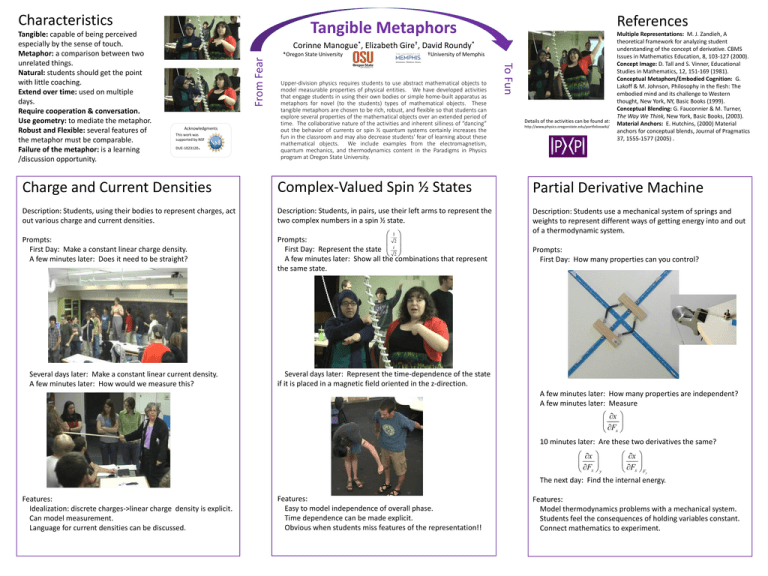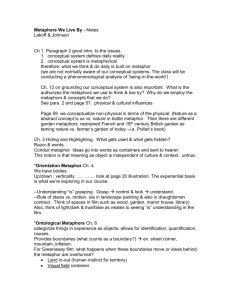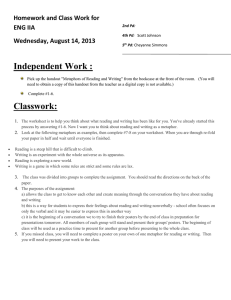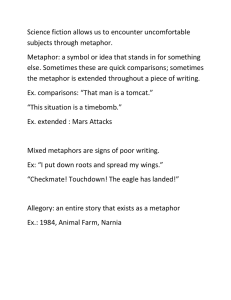Characteristics References
advertisement

Characteristics Tangible Metaphors From Fear Corinne Manogue*, Elizabeth Gire†, David Roundy* Acknowledgments This work was supported by NSF . DUE-1023120 *Oregon State University †University of Memphis Upper-division physics requires students to use abstract mathematical objects to model measurable properties of physical entities. We have developed activities that engage students in using their own bodies or simple home-built apparatus as metaphors for novel (to the students) types of mathematical objects. These tangible metaphors are chosen to be rich, robust, and flexible so that students can explore several properties of the mathematical objects over an extended period of time. The collaborative nature of the activities and inherent silliness of “dancing” out the behavior of currents or spin ½ quantum systems certainly increases the fun in the classroom and may also decrease students' fear of learning about these mathematical objects. We include examples from the electromagnetism, quantum mechanics, and thermodynamics content in the Paradigms in Physics program at Oregon State University. To Fun Tangible: capable of being perceived especially by the sense of touch. Metaphor: a comparison between two unrelated things. Natural: students should get the point with little coaching. Extend over time: used on multiple days. Require cooperation & conversation. Use geometry: to mediate the metaphor. Robust and Flexible: several features of the metaphor must be comparable. Failure of the metaphor: is a learning /discussion opportunity. References Details of the activities can be found at: http://www.physics.oregonstate.edu/portfolioswiki/ Multiple Representations: M. J. Zandieh, A theoretical framework for analyzing student understanding of the concept of derivative. CBMS Issues in Mathematics Education, 8, 103-127 (2000). Concept Image: D. Tall and S. Vinner, Educational Studies in Mathematics, 12, 151-169 (1981). Conceptual Metaphors/Embodied Cognition: G. Lakoff & M. Johnson, Philosophy in the flesh: The embodied mind and its challenge to Western thought, New York, NY, Basic Books (1999). Conceptual Blending: G. Fauconnier & M. Turner, The Way We Think, New York, Basic Books, (2003). Material Anchors: E. Hutchins, (2000) Material anchors for conceptual blends, Journal of Pragmatics 37, 1555-1577 (2005) . Charge and Current Densities Complex-Valued Spin ½ States Partial Derivative Machine Description: Students, using their bodies to represent charges, act out various charge and current densities. Description: Students, in pairs, use their left arms to represent the two complex numbers in a spin ½ state. Prompts: First Day: Make a constant linear charge density. A few minutes later: Does it need to be straight? 1 Prompts: i2 First Day: Represent the state 2 A few minutes later: Show all the combinations that represent the same state. Description: Students use a mechanical system of springs and weights to represent different ways of getting energy into and out of a thermodynamic system. Several days later: Make a constant linear current density. A few minutes later: How would we measure this? Prompts: First Day: How many properties can you control? Several days later: Represent the time-dependence of the state if it is placed in a magnetic field oriented in the z-direction. A few minutes later: How many properties are independent? A few minutes later: Measure x Fx 10 minutes later: Are these two derivatives the same? x x Fx y Fx Fy The next day: Find the internal energy. Features: Idealization: discrete charges->linear charge density is explicit. Can model measurement. Language for current densities can be discussed. Features: Easy to model independence of overall phase. Time dependence can be made explicit. Obvious when students miss features of the representation!! Features: Model thermodynamics problems with a mechanical system. Students feel the consequences of holding variables constant. Connect mathematics to experiment.





